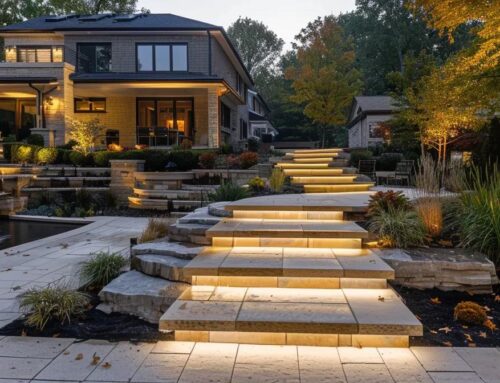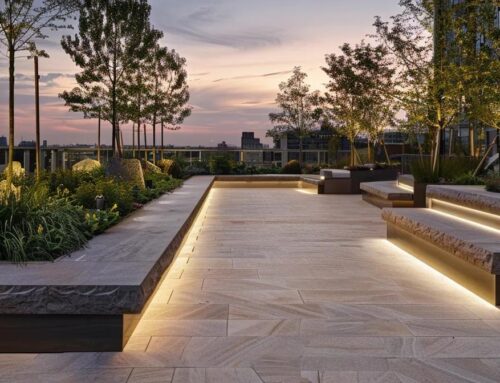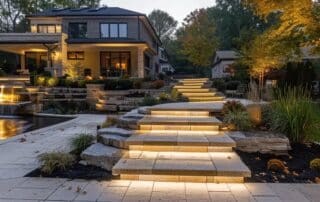Modern hardscape design transforms outdoor spaces into functional, aesthetically pleasing environments by integrating natural elements with engineered materials. For anyone looking for hardscape landscape solutions, exploring a diverse landscaping idea gallery can help spark innovative and sustainable designs. In my experience, creating successful hardscape projects means understanding the core design principles that enhance usability, sustainability, and beauty. Collaborating with experts like bretmarlandscape can further refine these ideas and ensure a flawless execution.
What Are the Core Principles of Modern Hardscape Design?
Modern hardscape design, enriched by bretmarlandscape expertise, is guided by cohesion between form and function, balance among design elements, and a commitment to sustainability. Many homeowners use a hardscape near me search to find local experts who understand this synergy. Every component—from pavers to retaining walls—must contribute to both the aesthetic appeal and practicality of the space, much like inspirations found on a landscaping idea gallery. Concepts such as the golden ratio and symmetry create an environment that is both naturally organic and structurally precise.
How Do Aesthetics Influence Modern Hardscape Design?
Aesthetics set the tone and mood of outdoor spaces. The visual appeal comes from carefully chosen materials, proportions, and colors that reflect contemporary trends. For example, neutral-colored pavers paired with accent lighting can evoke the soft ambiance of a minimalist interior. Designers use clean lines and simple forms, drawing on modern architecture principles to produce spaces that are as sophisticated as they are inviting.
Why Is Functionality Crucial in Hardscape Planning?
Hardscape design must serve practical needs as well as look attractive. The layout should facilitate ease of movement and accessibility while providing surfaces that withstand weather and heavy usage. A well-planned hardscape includes wide walkways for safety, seating areas for socializing, and drainage systems that prevent water buildup. I always assess the intended use of each area to ensure a seamless outdoor living experience for everyone.
How Does Sustainability Shape Modern Hardscape Choices?
Sustainability is now inseparable from hardscape design. It involves using recycled or locally sourced materials, permeable surfaces, and low-impact construction methods that reduce environmental footprints. Sustainable hardscaping conserves water, reduces urban heat island effects, and lowers long-term maintenance costs. Popular choices such as natural stone and composite decking support both environmental responsibility and durability, while designs often incorporate rain gardens and permeable paving to promote biodiversity.
Which Materials Are Best for Modern Hardscape Projects?
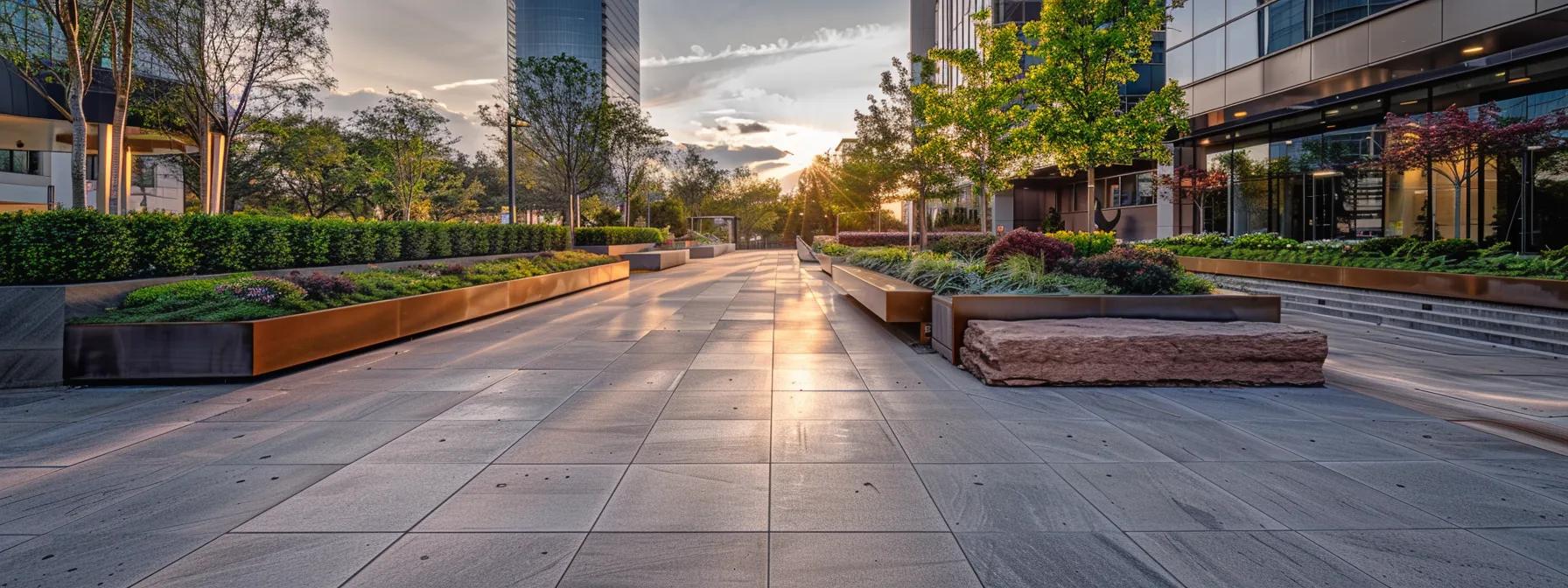
Selecting the right materials is crucial to balance durability, aesthetics, and environmental responsibility. Common materials include concrete, pavers, natural stone, and composite decking. Each has unique qualities that, when chosen wisely, contribute to a design that is both contemporary and timeless.
What Are the Benefits of Concrete and Pavers in Hardscaping?
Concrete and pavers are popular for their versatility and durability. Concrete can be molded into various shapes and colors to achieve both modern and traditional looks. Pavers allow creative layout designs and can be replaced or reconfigured easily when needed. Their modular nature is especially beneficial for large projects where future maintenance is considered. With proper installation, pavers can last over 50 years, making them a smart investment.
How Do Natural Stone and Composite Decking Compare?
Natural stone, like flagstone or slate, offers an organic, timeless appeal that fits naturally into outdoor settings. Its durability makes it ideal for patios and walkways. On the other hand, composite decking is engineered to mimic wood but offers enhanced durability and low maintenance, as it resists rot and fading better than traditional wood. While natural stone may require more precise installation and higher labor costs, composite decking often includes long warranty periods that help balance the overall cost with performance.
Why Choose Eco-Friendly Materials for Hardscape Design?
Eco-friendly materials are essential for reducing environmental impact. Options like recycled concrete, reclaimed stone, and composite decking made from recycled fibers minimize resource consumption and lower the project’s carbon footprint. Permeable pavers, for example, allow rainwater to recharge groundwater reserves, reducing runoff and erosion. Choosing sustainable materials improves environmental performance and appeals to clients focused on green building practices.
How Do Installation Techniques Impact Modern Hardscape Durability?
Even the best materials depend on quality installation. The longevity of a hardscape project hinges on proper grading, sub-base preparation, and effective drainage systems. Correct installation is fundamental in ensuring that the design remains stable and performs well under various weather conditions.
What Are the Best Practices for Paving and Grading?
Effective paving begins with a thorough site evaluation and proper sub-base preparation. The foundation must be compact and level to avoid future settling. Professionals use geotextile fabrics and crushed stone substrates to ensure optimal support and drainage. Critical grading and slope (with a recommended minimum of 1%) preserve surface integrity and facilitate efficient water runoff. I emphasize the importance of precision tools, like laser leveling, to achieve these results.
How Does Proper Drainage Enhance Hardscape Longevity?
Proper drainage is key to preventing issues such as freezing, cracking, and erosion. Incorporating features like French drains, swales, and permeable surfaces allows water to flow away from essential areas, thus protecting the structure. A well-designed drainage system that handles peak rainfall helps maintain durability by reducing the risk of water penetration and subsequent damage.
How Can Modern Hardscape Design Be Customized for Different Outdoor Spaces?
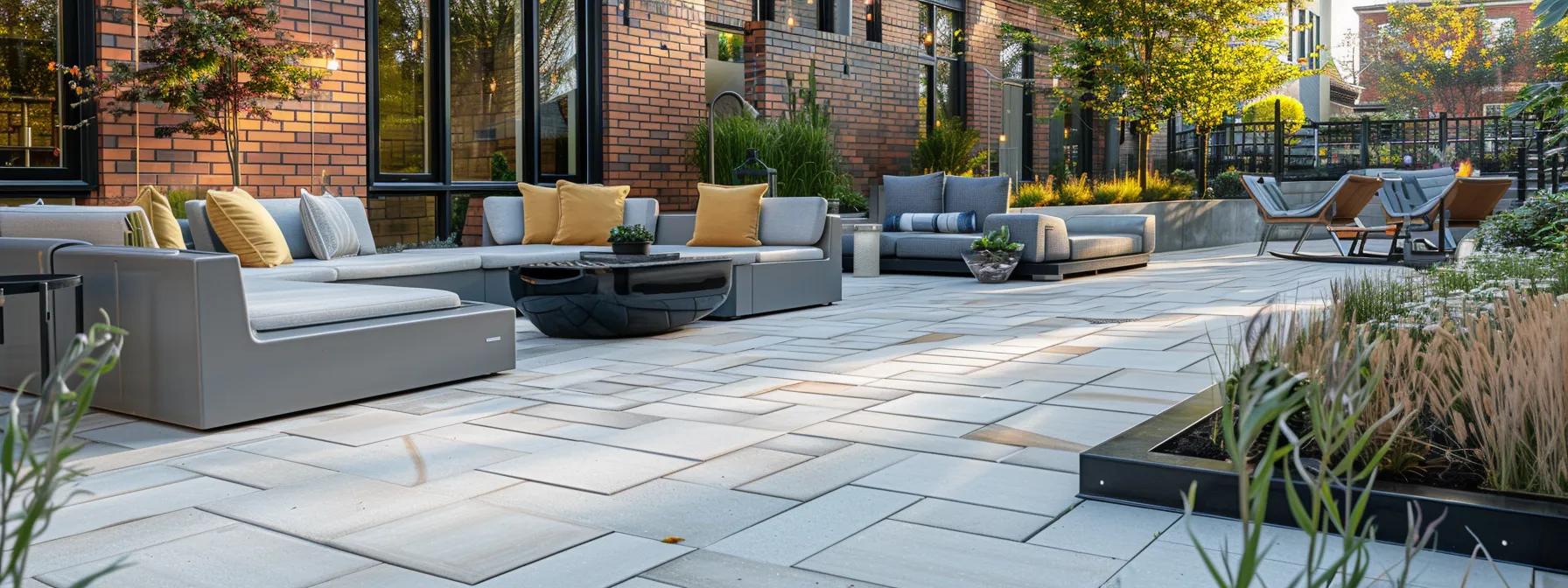
Customization is a major advantage of modern hardscape design. By tailoring design elements to specific site characteristics—such as spatial layout, climate, and intended use—designers create outdoor environments that maximize both function and visual appeal. The ability to adapt designs to unique settings ensures that each project enhances property value while meeting the client’s needs.
What Design Solutions Work Best for Patios and Walkways?
Patios and walkways must combine practicality with visual appeal. Patios generally use larger pavers or concrete slabs to create inviting spaces for outdoor furniture and gatherings, while walkways benefit from narrow, patterned pavers that guide movement. Strategies such as staggered layouts and curved lines create a natural flow and tactile interest, ensuring that both elements contribute to a cohesive outdoor design.
How to Integrate Outdoor Kitchens and Retaining Walls Seamlessly?
Integrating outdoor kitchens and retaining walls requires creative planning to ensure that all elements feel part of the same design. Outdoor kitchens often feature built-in countertops, grills, and storage that use materials like stainless steel, stone, and concrete to match the overall aesthetic. Retaining walls, aside from providing structural support, can become dramatic architectural features when coordinated with the color palette and materials of the outdoor kitchen. Techniques like step lighting and built-in planters help to create visual continuity and harmony across these elements.
How Do Site Conditions Influence Hardscape Customization?
Site conditions such as topography, soil composition, and local climate play a crucial role in shaping hardscape designs. On a sloping site, retaining walls are vital not only for erosion control but also for creating terraced spaces that maximize usability. In regions with heavy rainfall, designers prioritize permeable surfaces and efficient drainage systems to manage water effectively. A detailed site analysis ensures that the material and layout choices are appropriate for local weather extremes and environmental conditions.
What Are the Benefits of Sustainable Practices in Modern Hardscape Design?
Sustainable hardscape practices are no longer optional; they are essential. These practices not only provide environmental and economic benefits but also result in outdoor spaces that are resilient and low-maintenance. By reducing waste, lowering energy consumption, and conserving water, sustainable methods result in long-term savings and improved outdoor performance.
How Do Permeable Surfaces Contribute to Water Conservation?
Permeable surfaces allow water to infiltrate the ground rather than pooling on the surface, which helps to prevent erosion and damage. For instance, permeable pavers and porous concrete can lower surface runoff by a significant margin, mitigating urban heat island effects while promoting groundwater recharge. In my projects, the integration of these surfaces has consistently enhanced both the environmental and aesthetic performance of the design.
What Role Do Eco-Friendly Construction Methods Play?
Eco-friendly construction methods, such as accurate material measurements to reduce waste and the use of renewable energy during installation, are crucial in sustainable hardscape design. Recycling off-cuts, using low-VOC sealers, and minimizing site disruption help lower a project’s carbon footprint. These practices not only create a healthier environment but also contribute to safer and more durable constructions.
How Can Hardscape Design Support Environmental Responsibility?
Hardscape design can significantly support environmental responsibility through the integration of elements that conserve resources and promote biodiversity. By incorporating native plantings, green roofs, and efficient stormwater management systems, designers create spaces that reduce energy consumption and provide habitats for wildlife. Clients increasingly value designs that improve their property while positively impacting the local ecosystem.
How Do Landscape Architects and Designers Influence Modern Hardscape Projects?
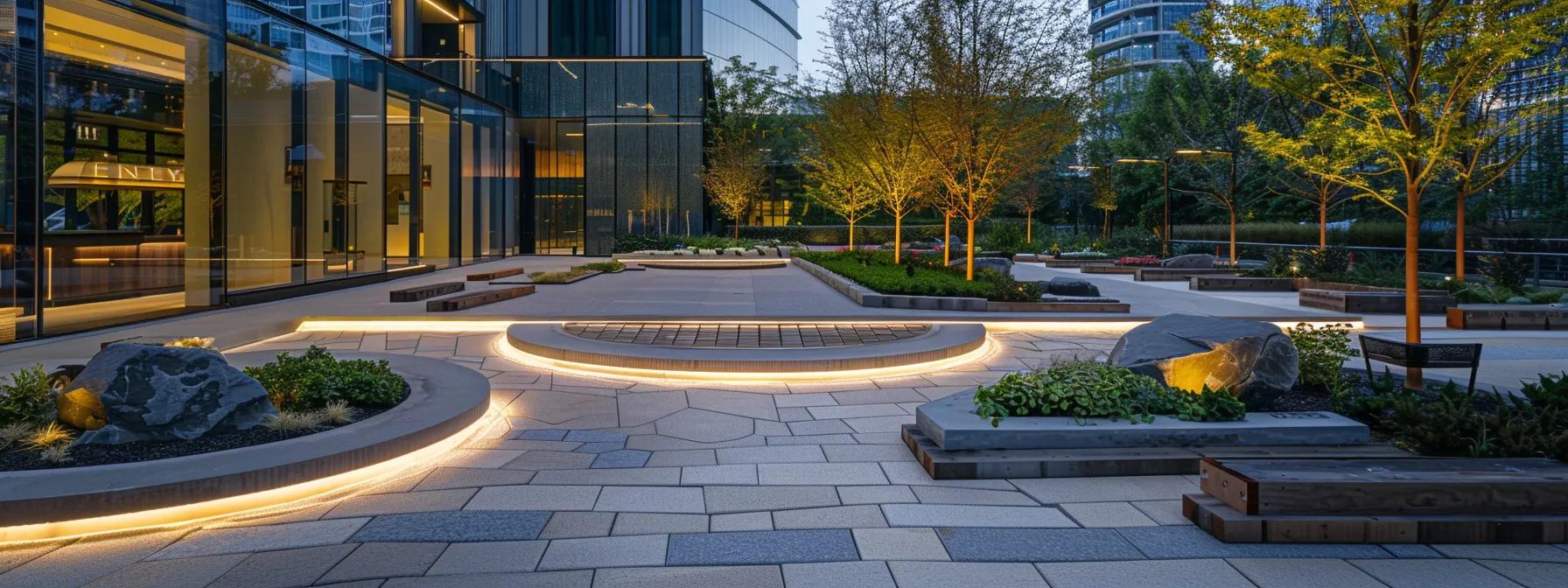
Landscape architects and designers are essential to modern hardscape projects because of their expertise in balancing aesthetics with functionality. They plan every detail so that both hardscape and softscape elements work together to create resilient and visually pleasing environments that meet client needs and environmental standards.
What Expertise Do Designers Bring to Hardscape Planning?
Designers understand materials, construction methods, and current trends. They analyze site conditions and client requirements to produce plans that enhance usability and sustainability while achieving high aesthetic appeal. Tools like computer-aided design (CAD) help simulate layout options, ensuring seamless integration of features such as pavers, retaining walls, and water elements. Their skill in translating abstract ideas into practical, buildable plans is key to successful hardscape design.
How Do Designers Balance Aesthetics and Functionality?
Balancing aesthetics with functionality is achieved through careful planning and ongoing refinements. Designers first identify the key uses of the space—whether for socializing, relaxation, or practical activities—and then choose materials and layouts that support the desired atmosphere. For example, pairing a striking pathway with a subtle permeable surface is one way to merge beauty and practicality. This iterative process helps ensure that the final design is both cohesive and user-friendly.
What Are the Latest Trends in Modern Hardscape Design?
Modern hardscape design is evolving as new materials, technologies, and sustainability imperatives continue to shape the industry. Current trends focus on innovative solutions that blend contemporary aesthetics with practical functionality, ensuring that outdoor spaces remain stylish and durable, even as climate and user needs change.
How Are Contemporary Styles Shaping Outdoor Living Spaces?
Contemporary styles increasingly prioritize simplicity, clean lines, and functional design. Drawing inspiration from modern architecture and the golden ratio, designers create open, uncluttered spaces with materials that exude strength and elegance. Elements such as pergolas, fire pits, and water features are integrated seamlessly into these spaces to form focal points that enhance overall visual appeal. Such designs also blur the boundaries between indoor and outdoor living areas, promoting a more integrated lifestyle.
What Innovative Materials and Techniques Are Emerging?
Advancements in materials and techniques are significantly transforming hardscape design. New high-performance concrete mixes that include recycled aggregates, state-of-the-art permeable paving systems, and advanced sealants that extend surface durability are setting new industry standards. Emerging techniques like laser leveling, 3D modeling, and precision grading allow for highly accurate execution and minimal waste. Additionally, smart outdoor lighting systems that adjust to ambient conditions and integrate with home automation systems are adding new layers of functionality and ambiance.
Frequently Asked Questions
Q: How does modern hardscape design integrate sustainability into its core principles?
A: It achieves sustainability by using eco-friendly materials, incorporating permeable surfaces for efficient water management, and employing construction practices that minimize waste and energy consumption.
Q: What makes concrete and pavers such popular materials for hardscape projects?
A: Their versatility, durability, and easy installation make them ideal for creating attractive and long-lasting outdoor surfaces.
Q: Can modern hardscape designs be customized to suit the specific needs of a site?
A: Yes, modern hardscape designs are highly customizable based on site conditions, intended use, and client preferences to ensure a unique solution for every project.
Q: What role do outdoor kitchens and retaining walls play in a hardscape design?
A: They serve dual roles by providing practical functionality—as cooking or socializing areas and structural support—while also enhancing the overall visual interest of the design.
Q: How do landscape architects balance aesthetics with functionality in hardscape projects?
A: They balance these aspects through careful planning, material selection, and integrating climate-resilient and drainage-focused strategies without compromising visual appeal.
Q: What are the benefits of using eco-friendly construction methods in hardscape design?
A: Eco-friendly methods lower environmental impact, reduce maintenance costs, promote water conservation, and result in outdoor structures that are more durable over time.
Q: How important is proper drainage in maintaining the longevity of a hardscape installation?
A: Critical—proper drainage prevents water buildup, reduces erosion and cracking, and extends the life of the hardscape by ensuring its stability.
Q: What are some emerging trends in modern hardscape design?
A: Emerging trends include the use of smart lighting technology, recycled and permeable materials, and minimalist designs influenced by modern architecture.
Q: How do installation techniques affect the durability of a hardscape project?
A: High-quality installation—with precise grading, a secure sub-base, and efficient drainage—is essential to ensure the project withstands harsh weather and maintains its performance over time.
Final Thoughts
Modern hardscape design successfully marries aesthetics, functionality, sustainability, and innovation. By adhering to key principles such as balance, environmental responsibility, and precise engineering, designers create outdoor spaces that are both visually appealing and highly resilient. The use of advanced materials and meticulous installation methods further ensures these designs meet practical needs and stand the test of time. Ultimately, modern hardscape trends elevate outdoor living standards while providing valuable insights for property managers and homeowners investing in quality, lasting projects.

